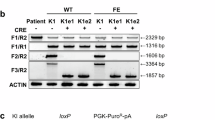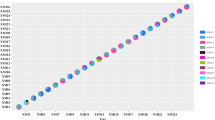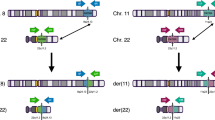Abstract
Among other applications of long-distance haplotype phasing in clinical genetics, determination of linked DNA markers as surrogate for problematic structural variants (e.g., repeat-mediated rearrangements) is essential to perform diagnosis from low-quality DNA samples. We describe a next-of-kin-independent (physical) phasing approach based on inverse-PCR (iPCR) paired-end amplification (PI). This method enables typing the multialleles of the short tandem repeat (STR) F8Int21[CA]n at the F8-intron 21, as a surrogate DNA marker for the F8-intron 22 inversion (Inv22), the hemophilia A-causative hotspot, within the transmitted haplotype in informative carriers. We provide proof-of-concept by blindly validating the PI approach in 15 carrier mother/affected-son duos. Every F8Int21[CA]n STR allele determined in phase with the Inv22 allele in the female carriers from the informative duos was confirmed in the hemizygous proband (P = 0.00003). A second surrogate STR locus at the F8-IVS22 was obtained by the PI approach improving severe-HA preimplantation genetic diagnosis by augmenting heterozygosity in Inv22 carriers bypassing the requirement for family linkage analysis. The ability of the PI-assay to combine other marker pairs was demonstrated by haplotyping a SNV (F8:c.6118T > C) with a >28kb-distant F8-IVS22 STR. The PI approach has proven flexibility to target different marker pairs and has potential for multiplex characterization of iPCR products by massively parallel sequencing.
Similar content being viewed by others
Log in or create a free account to read this content
Gain free access to this article, as well as selected content from this journal and more on nature.com
or
References
Morris RW, Kaplan NL. On the advantage of haplotype analysis in the presence of multiple disease susceptibility alleles. Genet Epidemiol. 2002;23:221–33.
Fernando MM, Stevens CR, Walsh EC, De Jager PL, Goyette P, Plenge RM, et al. Defining the role of the MHC in autoimmunity: a review and pooled análisis. PLoS Genet. 2008;4:e1000024.
Do C, Shearer A, Suzuki M, Terry MB, Gelernter J, Greally JM, et al. Genetic-epigenetic interactions in cis: a major focus in the post-GWAS era. Genome Biol. 2017;18:120.
International HapMap Consortium. Frazer KA, Ballinger DG, Cox DR, Hinds DA, Stuve LL, et al. A second generation human haplotype map of over 3.1 million SNPs. Nature. 2007;449:851–61.
The International HapMap 3 Consortium. Altshuler DM, Gibbs RA, Peltonen L, Dermitzakis E, Schaffner SF, et al. Integrating common and rare genetic variation in diverse human populations. Nature. 2010;467:52–8.
Shastry BS. Pharmacogenomics and pharmacoepigenomics in pediatric medicine. Methods Mol Biol. 2014;1175:671–85.
Apellániz-Ruiz M, Inglada-Pérez L, Naranjo ME, Sánchez L, Mancikova V, Currás-Freixes M, et al. High frequency and founder effect of the CYP3A4*20 loss-of-function allele in the Spanish population classifies CYP3A4 as a polymorphic enzyme. Pharm J. 2015;15:288–92.
Zheng GX, Lau BT, Schnall-Levin M, Jarosz M, Bell JM, Hindson CM, et al. Haplotyping germline and cancer genomes with high-throughput linked-read sequencing. Nat Biotechnol. 2016;34:303–11.
Hui WW, Jiang P, Tong YK, Lee WS, Cheng YK, New MI, et al. Universal haplotype-based noninvasive prenatal testing for single gene diseases. Clin Chem. 2017;63:513–24.
Lakich D, Kazazian HH, Antonarakis SE, Gitschier J. Inversions disrupting the factor VIII gene are common cause of severe Haemophilia A. Nat Genet. 1993;5:236–41.
Naylor J, Brinke A, Hassock S, Green PM, Giannelli F. Characteristic mRNA abnormality found in half the patients with severe haemophilia A is due to large inversions. Hum Mol Genet. 1993;2:1773–8.
Machado FB, Alves Da Silva AF, Rossetti LC, De Brasi CD, Medina-Acosta E. Informativeness of a novel multiallelic marker-set comprising an F8 intron 21 and three tightly linked loci for haemophilia A carriership analysis. Haemophilia. 2011;17:257–66.
Rossetti LC, Radic CP, Larripa IB, De Brasi CD. Developing a new generation of tests for genotyping hemophilia-causative rearrangements involving int22h and int1h hotspots in the factor VIII gene. J Thromb Haemost. 2008;6:830–6.
Sambrook J, Fritsch EF, Maniatis T. Molecular cloning. A laboratory manual. 2nd ed. New York, USA: Cold Spring Harbor Laboratory Press; 1989.
Lahiri DK, Nuremberg JI. A rapid non-enzymatic method for the preparation of HMW DNA from blood for RFLP studies. Nucl Acids Res. 1991;19:5444.
Rossetti LC, Radic P, Larripa IB, De Brasi CD. Genotyping the hemophilia inversion hotspot by use of inverse PCR. Clin Chem. 2005;51:1154–8.
Liang Y, Zhao Y, Yan M, Fan XP, Xiao B, Liu JZ. Prenatal diagnosis of haemophilia A in China. Prenat Diagn. 2009;29:664–7.
Zhao M, Chen M, Tan ASC, Cheah FSH, Mathew J, Wong PC, et al. Single-tube tetradecaplex panel of highly polymorphic microsatellite markers <1 Mb from F8 for simplified preimplantation genetic diagnosis of hemophilia A. J Thromb Haemost. 2017;15:1473–83.
Liu Q, Nozari G, Sommer SS. Single-tube polymerase chain reaction for rapid diagnosis of the inversion hotspot of mutation in haemophilia A. Blood. 1998;92:1458–9.
Machado FB, Medina-Acosta E. High-resolution combined linkage physical map of short tandem repeat loci on human chromosome band Xq28 for indirect haemophilia A carrier detection. Haemophilia. 2009;15:297–308.
De Rycke M, Belva F, Goossens V, Moutou C, SenGupta SB, Traeger-Synodinos J, et al. ESHRE PGD Consortium data collection XIII: cycles from January to December 2010 with pregnancy follow-up to October 2011. Hum Reprod. 2015;30:1763–89.
Traeger-Synodinos J. Pre-implantation genetic diagnosis. Best Pract Res Clin Obstet Gynaecol. 2017;39:74–88.
Citterio CE, Rossetti LC, Souchon PF, Morales C, Thouvard-Viprey M, Salmon-Musial AS, et al. Novel mutational mechanism in the thyroglobulin gene: imperfect DNA inversion as a cause for hereditary hypothyroidism. Mol Cell Endocrinol. 2013;381:220–9.
Hosomichi K, Jinam TA, Mitsunaga S, Nakaoka H, Inoue I. Phase-defined complete sequencing of the HLA genes by next-generation sequencing. BMC Genomics. 2013;14:355.
Scott SA, Tan Q, Baber U, Yang Y, Martis S, Bander J, et al. An allele-specific PCR system for rapid detection and discrimination of the CYP2C19*4A, *4B, and *17 alleles: implications for clopidogrel response testing. J Mol Diagn. 2013;15:783–9.
Sim SC, Ingelman-Sundberg M. The Human Cytochrome P450 (CYP) Allele Nomenclature website: a peer-reviewed database of CYP variants and their associated effects. Hum Genomics. 2010;4:278–81.
Zanger UM, Klein K. Pharmacogenetics of cytochrome P450 2B6 (CYP2B6): advances on polymorphisms, mechanisms, and clinical relevance. Front Genet. 2013;4:24.
Jeffreys AJ, Kauppi L, Neumann R. Intensely punctate meiotic recombination in the class II region of the major histocompatibility complex. Nat Genet. 2001;29:217–22.
Kolovos P, Knoch TA, Grosveld FG, Cook PR, Papantonis A. Enhancers and silencers: an integrated and simple model for their function. Epigenetics Chromatin. 2012;5:1.
Mora A, Sandve GK, Gabrielsen OS, Eskeland R. In the loop: promoter-enhancer interactions and bioinformatics. Brief Bioinformatics. 2016;17:980–95.
Jeffreys AJ, Neumann R. Factors influencing recombination frequency and distribution in a human meiotic crossover hotspot. Hum Mol Genet. 2005;14:2277–87.
Turner DJ, Tyler-Smith C, Hurles ME. Long-range, high-throughput haplotype determination via haplotype-fusion PCR and ligation haplotyping. Nucleic Acids Res. 2008;36:e82.
Zhang K, Zhu J, Shendure J, Porreca GJ, Aach JD, Mitra RD, et al. Long-range polony haplotyping of individual human chromosome molecules. Nat Genet. 2006;38:382–7.
Regan JF, Kamitaki N, Legler T, Cooper S, Klitgord N, Karlin-Neumann G, et al. A rapid molecular approach for chromosomal phasing. PLoS ONE 2015;10:e0118270.
Kaper F, Swamy S, Klotzle B, Munchel S, Cottrell J, Bibikova M, et al. Whole-genome haplotyping by dilution, amplification, and sequencing. Proc Natl Acad Sci USA. 2013;110:5552–7.
Snyder MW, Adey A, Kitzman JO, Shendure J. Haplotype-resolved genome sequencing: experimental methods and applications. Nat Rev Genet. 2015;16:344–58.
Acknowledgements
This study was supported by grants from the National Research Council (CONICET), National Agency for Scientific and Technological Promotion (ANPCyT) and the World Federation of Hemophilia. The authors thank Miguel de Tezanos Pinto (National Academy of Medicine and National Hemophilia Foundation) and Judith Mincman and Roberto Cocco (Fecunditas Clinic) for their help in different phases of the work.
Authors contributions
All authors have contributed to the intellectual content of this paper and have met the following three requirements: (a) significant contributions to the conception and design, acquisition of data, or analysis and interpretation of data; (b) drafting or revising the article for intellectual content; and (c) final approval of the manuscript.
Author information
Authors and Affiliations
Corresponding author
Ethics declarations
Conflict of interest
The authors declare that they have no conflict of interest.
Ethics statement
The Ethics Committee of the Institutes of the National Academy of Medicine of Buenos Aires, Argentina, approved the project (date: 13/06/2012). Peripheral blood samples from participating control, carrier, and hemophilia subjects in nuclear families were collected with written informed consent.
Additional information
Publisher’s note: Springer Nature remains neutral with regard to jurisdictional claims in published maps and institutional affiliations.
Rights and permissions
About this article
Cite this article
Abelleyro, M.M., Marchione, V.D., Palmitelli, M. et al. Inverse PCR to perform long-distance haplotyping: main applications to improve preimplantation genetic diagnosis in hemophilia. Eur J Hum Genet 27, 603–611 (2019). https://doi.org/10.1038/s41431-018-0334-9
Received:
Revised:
Accepted:
Published:
Issue date:
DOI: https://doi.org/10.1038/s41431-018-0334-9
This article is cited by
-
Rapid genotyping of F8 intron 22 inversion by nested PCR based on long-distance PCR
Journal of Thrombosis and Thrombolysis (2020)



